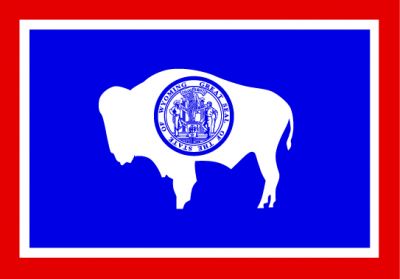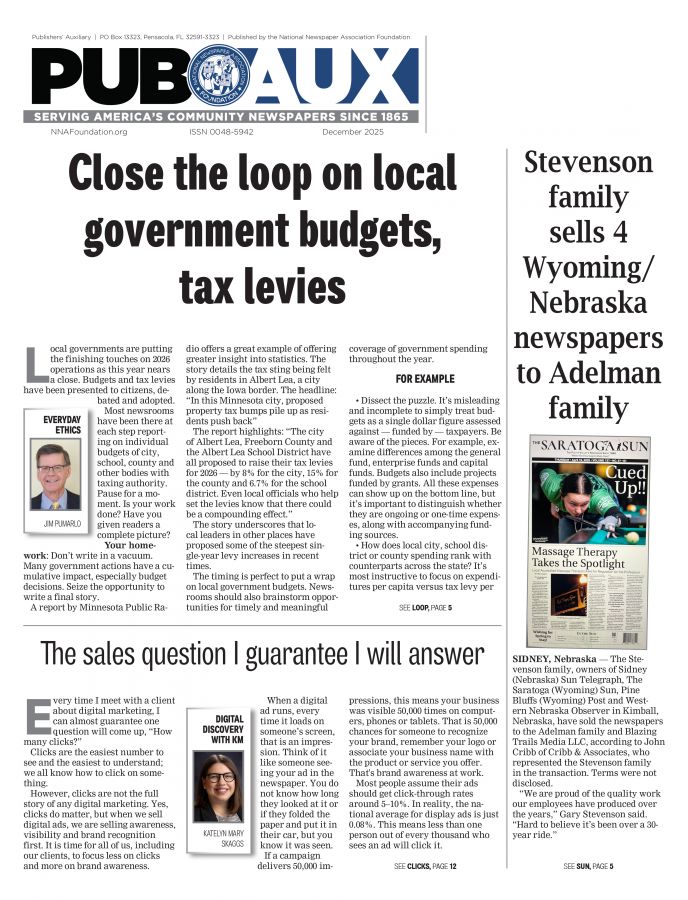Public notice picture coming into focus
Public Notice Resource Center & NNA
Oct 1, 2023


With only eight state legislatures still in session, the legislative die for 2023 has largely been cast. There’s always a chance that one of those states could still make mischief, but when the calendar turns to Dec. 31, it’s likely we’ll be able to say it was a pretty good year for public notice.
PNRC has been tracking approximately 230 bills introduced this year that have at least a minimal connection to public notice law. Forty-eight have been signed into law. Of those 48 bills, 13 will probably have a slightly negative effect on government transparency, while the impact of about 20 others will be moderately positive. The remainder will have little to no substantive effect.
Another positive is that the self-storage industry wasn’t able to make any progress this year in their quest to eliminate lien-sale notices. Self-storage operators went 0 for 6 on bills designed to allow them to avoid having to publish those notices in local newspapers. After getting at least four such bills passed in both 2021 and 2022, the self-storage folks went down to defeat this year in California, Florida, Missouri, New Mexico, Oregon and Texas.
The only significant public notice legislation enacted since our last issue was Oregon HB-3167, the passage of which made Oregon the second state to give e-editions the same statutory force as printed newspapers. North Dakota approved a similar provision earlier this year. HB-3167 also allowed free-circulation papers to qualify to publish notice in limited circumstances and added content standards to the state’s public notice law, including a requirement that “at least 25 percent of the total news content is locally and originally composed by the newspaper.” The bill took effect when it was signed by the governor on July 13.
AG supports newspaper notice in Wyoming lawsuit
Two municipalities in Wyoming passed nearly identical ordinances in 2021 (https://bit.ly/3PKqZji) exempting themselves from state statutes mandating the publication of various notices in their local paper of record. A lawsuit subsequently filed by that paper — Lee Enterprise’s Casper Star-Tribune — seeks to compel the cities of Mills and Bar Nunn to publish those notices within its pages.
The Star-Tribune is the official newspaper of Natrona County. Mills and Bar Nunn are small but growing communities within the county.
Last month, the state of Wyoming weighed in on the side of the Star-Tribune. The attorney general’s office filed a brief in the case, arguing the state’s public notice laws are valid and must be followed by both local governments.
Both ordinances approved by the municipalities claim that newspaper ads are “an inefficient means of providing notice at the present time, fails to give adequate notice and is an expense imposed upon the town, which is not calculated to achieve the desired effect.” As an alternative, the new rules allow Mills and Bar Nunn to post notices at three public places in town, one of which apparently includes their websites.
According to Cowboy State Daily, (https://bit.ly/3PpP5P2) the attorney representing the two small towns has argued in court filings that the state’s public notice statutes violate both the state and federal constitutions. He contends that statutory construction evolves over time and that references to newspapers in Wyoming’s public notice laws should now be understood to also mean “electronic journals.” He also claims the statutes apply to counties but not municipalities and that his clients have the power to determine how to provide public notice under the state constitution’s “home rule” provision.
Star-Tribune lawyer Bruce Moats tells us that specific references to newspaper notices are spread throughout Wyoming’s legal code and that the state’s general public notice statute (Title 18, Chapter 3, Article 5, Sections 517-519 — https://bit.ly/3RuA1SQ) clearly states that “any legal notice, printing or advertising required by law is without force or effect unless published in a newspaper.” Moats also says home rule doesn’t apply in this case because municipalities can’t exempt themselves from statutes uniformly applicable to all cities and towns, like Wyoming’s public notice laws.
“This issue should be resolved in the legislature, not the courts,” Moats argues. “A court ruling would eliminate local notice requirements without replacing them.”
The next hearing in the case is scheduled to be held Sept. 14 in Natrona County District Court. The trial, if one should be necessary, is set for October.
Moats has represented the Wyoming Press Association and newspapers in the state for over 40 years. He announced his retirement earlier this year (https://bit.ly/3EOhIAq) and the Mills-Bar Nunn case will be one of his last. He’s optimistic.
“We have a strong case,” Moats says. “I feel good about our chances.”
Maneke: Beware of giving legal advice
Jean Maneke is a lawyer and former reporter. She is based in Kansas City, Missouri, and serves as legal hotline attorney for the Missouri Press Association. This article was adapted from a column originally published in the August issue of MPA’s monthly magazine, Missouri Press News.
Editor's note: Jean's advice specifically applies to Missouri. Readers should check with their own press associations about legal notice requirements.
When the calendar turns to August, it’s always a reminder that political races are coming up. This year is an off-year for most of us in Missouri, but it seems like a good time to talk to your advertising staff about reminders related to running political ads and other ad issues. ...
(L)egal notices create their own special challenges. Legal notices for foreclosures present a huge risk for newspapers. A lot of attorney work goes into the preparation for publication of a foreclosure notice, and if a newspaper fails to properly publish it for the dates it needs to run, all of that work goes down the drain. The process must be restarted, and the cost to the advertiser in terms of attorneys fees explodes.
The simple solution for a newspaper is to have double-checks in place to ensure that failure to publish never happens. There just is no easy “make good” available. A lawyer who says you cannot just run it one extra week for free is not being stubborn; the lawyer is doing what is required under state law.
Yes, it is the right thing if your failure to catch the error caused the re-do, to offer to pay the cost to re-do the legal work that precedes the running of the legal notice. That’s why this should never happen.
At the same time, it’s good practice for a paper to decline to give legal advice to a lawyer who calls to ask how many times a notice should run. I have a perfect example that happened to me just this past month. I published a notice for a self-storage unit sale for a client. I researched it before placing the ad and believed it only needed to run one time. It ran, and then in the period between publication and the sale, my client called with a question that caused me to hunt again for the statutes. In doing that, I first saw a statute that called for publication twice. I panicked, and my first thought was that we would need to re-do the advertising step.
Fortunately, I kept reading and in due course determined that the statute I was reading applied to warehouse operators, while the self–storage statutes were different. Once was all that was required.
This business of “reading the statutes” is a difficult task. Don’t let an advertiser ask you to tell them how many times a notice should run. Don’t step in and attempt to give an advertiser legal advice.
Do what they tell you to do, and make it clear that the advertiser is responsible for deciding when and how often the ad runs, not the paper. Be safe, not sorry!









